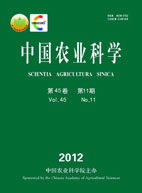-
Study on Collaborating Characteristics of Grain Yield Components and Panicle Traits of Large Panicle Hybrid Japonica Rice
- GONG Jin-Long, HU Ya-Jie, LONG Hou-Yuan, CHANG Yong, LI Jie, ZHANG Hong-Cheng, MA Rong-Rong, WANG Xiao-Yan, DAI Qi-Gen, HUO Zhong-Yang, XU Ke, WEI Hai-Yan, DENG Zhang-Ze, MING Qing-Long
-
Scientia Agricultura Sinica. 2012, 45(11):
2147-2158.
doi:10.3864/j.issn.0578-1752.2012.11.003
-
 Abstract
(
1098 )
Abstract
(
1098 )
 PDF (591KB)
(
914
)
PDF (591KB)
(
914
)
 Save
Save
-
References |
Related Articles |
Metrics
【Objective】The objective of this study was to reveal sink components characteristics and panicle traits of large panicle hybrid japonica rice and explore approaches to increase group productivity of it. 【Method】A field experiment was conducted with eight representative large panicle hybrid japonica rice varieties (A18/F7562, A2/F7563, A20/F7501, A5/F9249, A2/F7513, A20/F7503, Yongyou 8 and Yongyou 13) and two medium panicle conventional japonica rice varieties (Wuyunjing 7 and Wujing 15) as materials. Grain yield components characteristics, total spikelets, sink and panicle traits of large panicle hybrid japonica rice were analyzed systematically. 【Result】Grain yield, total spikelets, sink, panicle length, grain density, grain weight per panicle, No. of branches of primary branches per panicle, grains per branch of primary branches, total grains of primary branches per panicle, No. of branches of secondary branches per panicle, grains per branch of secondary branches and total grains of secondary branches per panicle of large panicle hybrid japonica rice were higher than medium panicle conventional japonica rice significantly, while No. of panicles, seed-setting rate, 1000-grain-weight, seed-setting rate of primary branches and seed-setting rate of secondary branches followed an opposite tendency accordingly. With the increasing spikelets per panicle, grain yield, total spikelets, sink and seed-setting rate of secondary branches of large panicle hybrid japonica rice increased firstly and then decreased, while panicle length, grain density, grain weight per panicle, No. of branches of primary branches per panicle, grains per branch of primary branches, total grains of primary branches per panicle, No. of branches of secondary branches per panicle, grains per branch of secondary branches and total grains of secondary branches per panicle followed a growing trend and No. of panicles, seed-setting rate, 1000-grain-weight, ratio of No. of branches of primary branches to No. of branches of secondary branches, ratio of total grains of primary branches to total grains of secondary branches and seed-setting rate of primary branches did with a declining tendency accordingly. The others and spikelets per panicle were significantly correlated with the exception of grain yield, sink and seed-setting rate of secondary branches. In order to enlarge spikelets per panicle, it was almost contributed by primary branches from medium panicle to prejudiced large panicle, and secondary branches were the major factors from prejudiced large panicle to large panicle (from large panicle to extra large panicle or from extra large panicle to super large panicle). The increase of 1000-grain-weight was the key point of harvesting super high yield of large panicle hybrid japonica rice on the basis of certain No. of panicles and stabilized seed-setting rate. Increase of total spikelets was the basis of increase of grain yield, while the emphasis was to increase sink. Therefore, stable 1000-grain-weight was needed for increasing total spikelets. 【Conclusion】 Under the experimental conditions, the applicable spikelets per panicle (250 or so) was the best choice for ideal grain yield and its components with high total spikelets and sink filling for large panicle hybrid japonica rice. With the advancement of breeding and techniques, its optimum would be higher.









